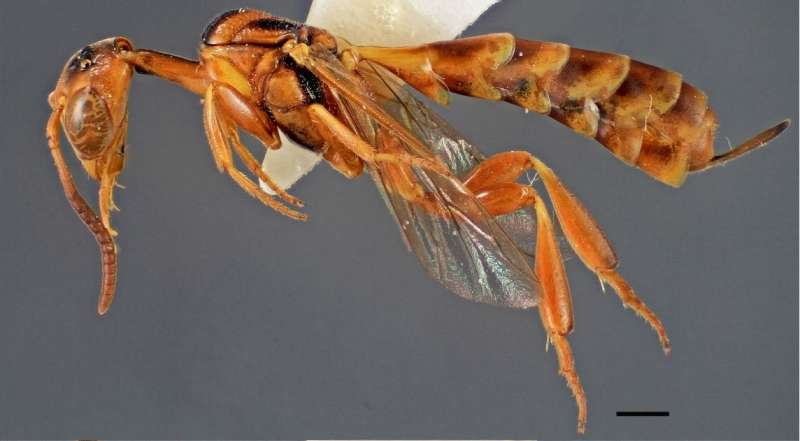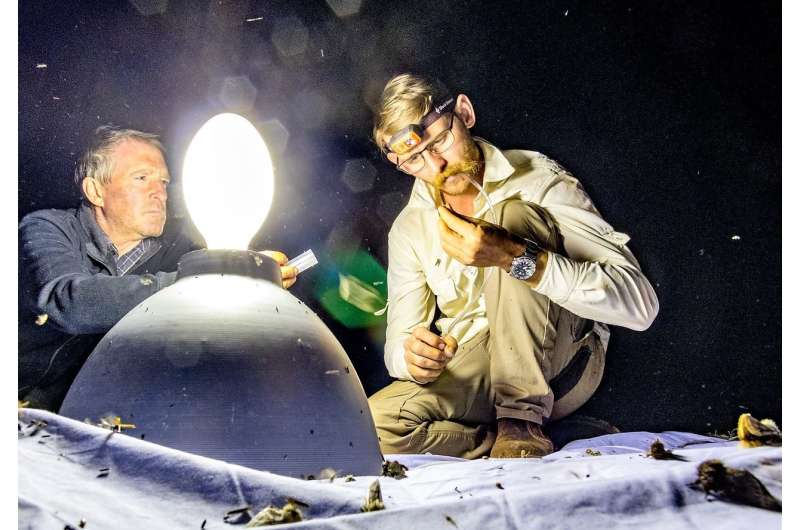The 11th species of an endemic Australian wasp genus

As well as an interest in all insects, Flinders biological sciences Ph.D. Ben Parslow has a fascination for wasps.
The focus of his doctorate research on the wasp genus Gasteruption has accidently has put him on the trail of describing the 11th species of an endemic Australian wasp genus.
It's estimated that there are three times the 10,140 or so described species of wasps still to be identified by scientists in Australia.
As such, he was most excited to come across a "really interesting looking wasp" in material loaned from a collection at the Museum and Art Gallery of the Northern Territory.
"These Hyptiogaster wasps are uncommonly collected and the material was loaned to myself hidden among other wasps I am borrowing for my Ph.D. research," he says.
"It was a strange looking wasp and as soon as I saw it, it piqued my interest.
"After checking it against the described material, we were sure it was something new."
With University of Adelaide mentor Dr. John Jennings, the "new" Hyptiogaster wasp has been described in a new paper in Zootaxa.
"This species is the first of the genus to be described from the Northern Territory," he says.

"Unlike the other species, it is yellowy-brown in colour and long neck (all other species have short necks) which makes it a very interesting species."
Like many wasps, little is known of the biology of Hyptiogaster, Ben explains.
"They are apparently parasitic or predator-inquilines in the nests of pollen wasps and ground-nesting bees.
"What this means is the adult wasp waits until the host has left their nest unattended before sneaking in and laying an egg on/near the host egg/provisions.
"The wasp egg hatches and the wasp larvae consumes the host larvae and food provisions before continuing it development inside the host nest."
Recording insects from remote areas such as the Arafura Swamp in the plays a vital role in learning about Australia's biodiversity, he says.
"It's a fantastic way to highlight the significance of this culturally significant area and understand the role more of the animals might play in the ecology and conservation of these areas."
As well as entomology, Ben, who is supervised by Flinders Associate Professor Mike Schwarz and the South Australian Museum Associate Professor Mark Stevens, has been promoting zoology and ecology with biology students at the College of Science and Engineering.
He supervises at the SA Museum and School of Biology Association at Flinders.
While studying for his Ph.D. at Flinders, Ben hopes to 'discover' more Australian wasps as part of his current project: 'Systematics and host associations of the Australian Gasteruption (Hymenoptera: Gasteruptiidae).'
Hyptiogaster arafura sp. nov. is described from Arafura Swamp, Northern Territory, Australia, as the 11th species of Hyptiogaster Kieffer (Hymenoptera: Gasteruptiidae).
More information: BEN A. PARSLOW et al. A new species of the endemic Australian genus Hyptiogaster Kieffer Hymenoptera: Gasteruptiidae), Zootaxa (2018). DOI: 10.11646/zootaxa.4379.1.11
Journal information: Zootaxa
Provided by Flinders University




















